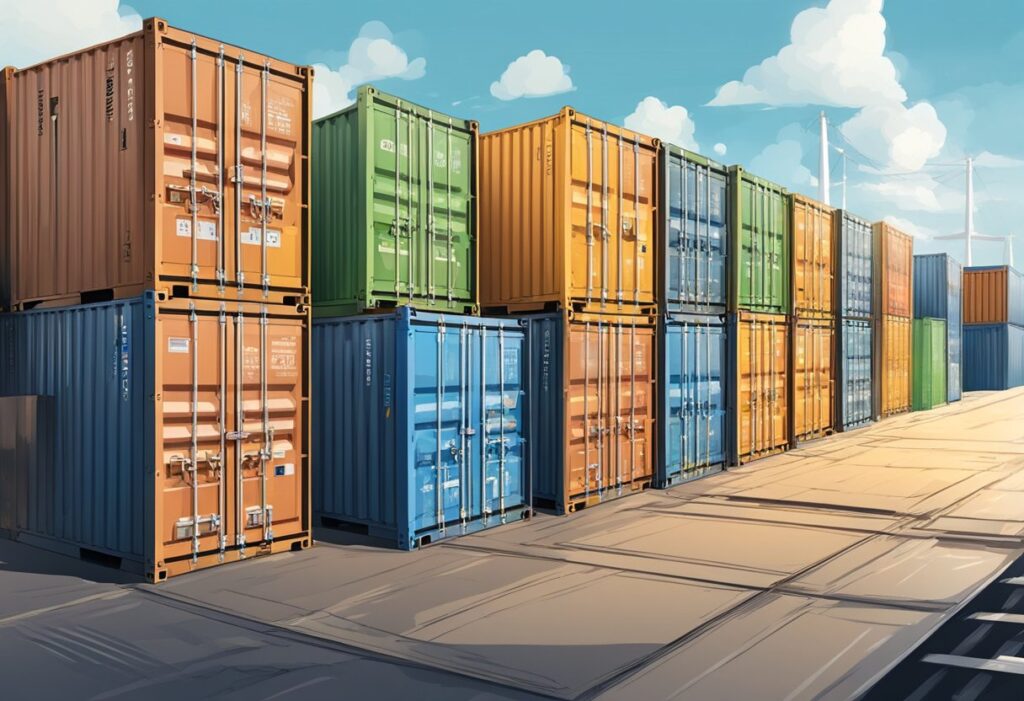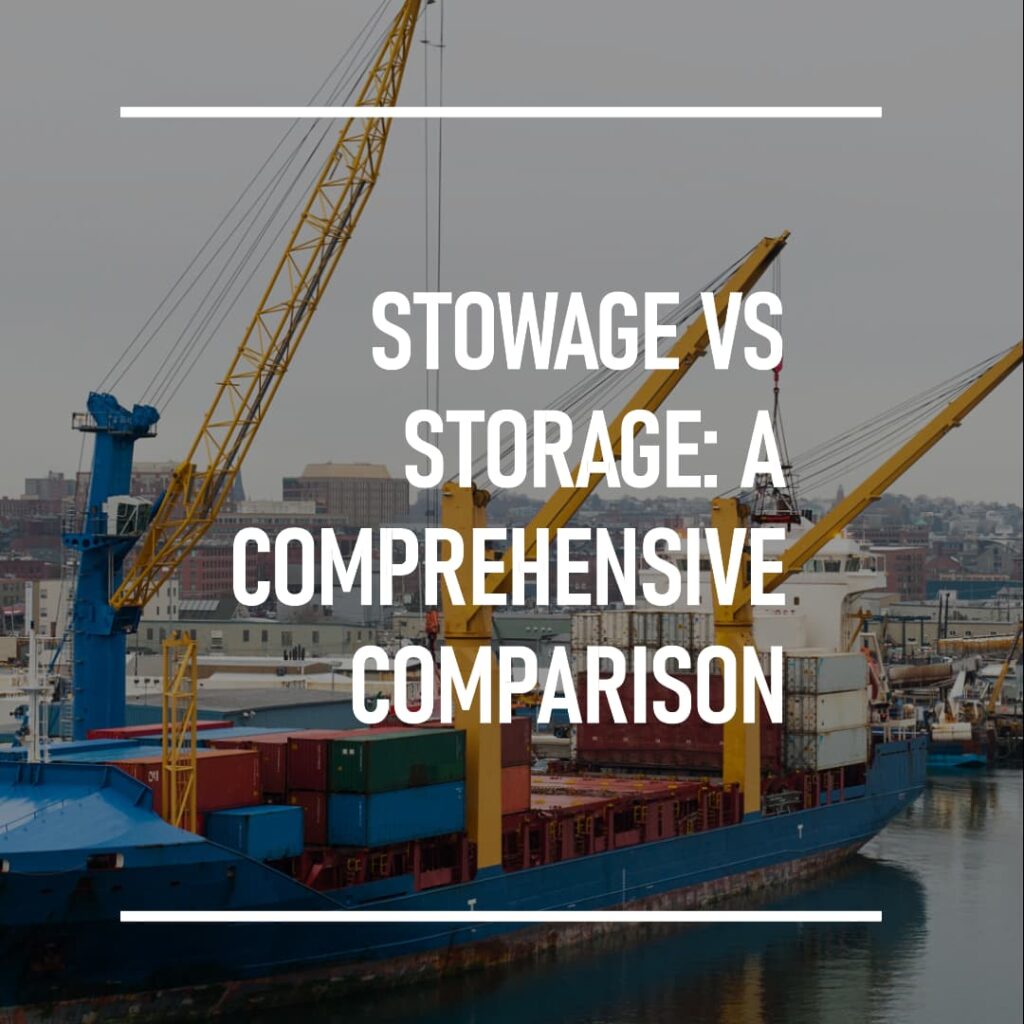Stowage and storage are two terms that are often used interchangeably in the shipping industry, but they have distinct meanings and applications.
Storage refers to the act of keeping something in a particular place, while stowage refers to the process of packing or arranging items in a specific way for transportation or storage.
Understanding the difference between these terms is crucial for businesses involved in shipping, from warehouses to ships.

In the shipping industry, goods require safe and secure storage to protect them from damage and destruction due to careless handling, pilferage, and the elements of nature.
Warehouses are buildings and related infrastructure that are used for the storage of goods. On the other hand, stowage planning refers to the arrangement of cargo on board a container vessel or a ship’s hold.
It involves different objectives, such as optimizing the available space, ensuring stability and safety, and complying with regulations and standards.
To ensure efficient and effective shipping operations, businesses need to consider both stowage and storage in their logistics and supply chain management. This article will explore the differences between stowage and storage, their applications in the shipping industry, and best practices for businesses to optimize their use.
Understanding Stowage and Storage
Stowage and storage are two terms that are often used interchangeably, leading to confusion in the shipping industry. While both terms refer to the act of keeping goods in a particular place, they are used in different contexts.
Storage generally refers to long-term arrangements for keeping items in a warehouse or a storage unit. On the other hand, stowage refers to the short-term arrangement of packing items in a cargo hold or a shipping container.
When it comes to shipping, stowage planning is the arrangement of containers on board a container vessel. The stowage of a container ship involves different objectives, such as optimizing the available space and ensuring the safety of the goods being transported.
It is important to note that stowage and storage are not synonyms for each other. While stowage refers to the space or compartment where something is stored, storage is the act of keeping items in a particular place.
To avoid confusion, it is recommended to use the term “stowage” when referring to the arrangement of goods in a shipping container or cargo hold. The term “storage” should be used when referring to the long-term keeping of goods in a warehouse or storage unit.
In shipping, the stowage factor is an important consideration. It indicates how many cubic meters of space one tonne of cargo occupies in the hold of a cargo ship.
The stowage factor is calculated as the ratio of the stowage space required under normal conditions, including the stowage losses caused by the means of transportation and packaging, to the weight of the cargo.
Overall, understanding the difference between stowage and storage is crucial in the shipping industry to ensure efficient and safe transport of goods.
Stowage Vs Storage: Key Differences

When it comes to the transportation of goods, the terms “stowage” and “storage” are often used interchangeably. However, there are some key differences between the two. In this section, we will explore these differences and examine the practices of stowage and storage in the shipping industry.
Stowage Practices on Ships
Stowage is the process of packing or arranging items in a specific way to optimize space utilization. In the shipping industry, stowage refers to the arrangement of cargo on board a ship to ensure that it is secure and does not move around during transportation. Stowage is crucial in ensuring the safety of the cargo and the crew.
Stowage practices on ships involve the use of various units, including containers, pallets, and bulkheads.
Containers are the most common unit used for stowage on ships. They come in different sizes and are designed to fit together, allowing for efficient use of space. Pallets are used to stack goods and are often used in conjunction with containers.
Bulkheads are used to divide the cargo hold into compartments, allowing for better weight distribution and stability.
Cargo stowage planning is an important aspect of shipping. It involves determining the best way to load and secure the cargo on board the ship. The stowage plan takes into account the weight, size, stowage factor, and type of cargo, as well as the ship’s stability and the weather conditions.
Storage Practices in Warehouses
Storage, on the other hand, is the act of storing goods in a warehouse or other facility. Storage practices in warehouses involve the use of various units, including shelves, racks, and bins. These units are designed to maximize space utilization and make it easier to locate and retrieve goods.
In warehouses, goods are stored in units known as shipments. A shipment is a collection of goods that are transported together.
Shipments can be stored in different areas of the warehouse, depending on their size and type. For example, small items may be stored on shelves, while larger items may be stored on pallets.
Warehouse storage also involves the use of inventory management systems. These systems help to track the location and quantity of goods in the warehouse, making it easier to manage inventory levels and ensure that goods are available when needed.
In conclusion, while stowage and storage are both important aspects of the transportation of goods, they refer to different processes.
Stowage involves the arrangement of cargo on board a ship, while storage involves the storage of goods in a warehouse or other facility. Understanding these differences is crucial in ensuring the safe and efficient transportation of goods.
Cost Considerations in Stowage and Storage

When it comes to shipping goods, cost considerations are a crucial factor in deciding between stowage and storage.
Stowage refers to the arrangement of containers on board a container vessel, while storage involves packing or arranging items in a specific way to optimize space utilization in a storage facility. Here are some cost considerations to keep in mind when choosing between stowage and storage:
Shipping Costs
Shipping costs can vary depending on the mode of transportation, distance, and weight of the goods being shipped.
Stowage may be a more cost-effective option for shipping large quantities of goods over long distances, as it maximizes the use of available space on a container vessel.
However, storage may be a better option for smaller shipments or for goods that need to be stored temporarily before being shipped.
Storage Capacity
Storage capacity is another important cost consideration. Self-storage facilities may be a more affordable option for short-term storage needs, whereas warehouses may be a better option for long-term storage needs.
The cost of storage also depends on the amount of space required and the duration of storage needed.
Logistics and Delivery
Logistics and delivery costs are also important factors to consider. Stowage can help reduce logistics costs by optimizing the use of available space on a container vessel, but it may also require additional handling and transportation costs once the goods reach their final destination.
Storage, on the other hand, may result in lower transportation costs but may require additional handling and storage costs.
Inventory Management
Effective inventory management is crucial for minimizing storage costs. This includes tracking inventory levels, identifying slow-moving items, and optimizing storage space.
Stowage can help reduce inventory costs by maximizing the use of available space on a container vessel, but it may also require additional handling and storage costs.
Storage facilities may offer inventory management services to help businesses optimize their storage space and reduce costs.
Markets and Supply Chain
Market demand and supply chain considerations can also impact the cost of stowage and storage. For example, if there is high demand for certain goods in a particular market, stowage may be a more cost-effective option for shipping large quantities of goods to that market.
However, if the demand for certain goods is low, storage may be a better option for storing those goods until market conditions improve.
In conclusion, cost considerations are an important factor in deciding between stowage and storage.
Businesses should carefully evaluate their shipping and storage needs and consider factors such as shipping costs, storage capacity, logistics and delivery, inventory management, and market demand when making their decision.
Safety and Security in Stowage and Storage
Ensuring the safety and security of cargo during stowage and storage is of utmost importance in the shipping industry. The careless handling of cargo can result in damage to the cargo, the ship, and even cause accidents that may lead to loss of life. Therefore, it is crucial to employ secure stowage and storage practices to prevent such incidents from happening.
One way to ensure the safe stowage of cargo is by using proper racking and storage services. These services provide a secure environment for cargo, reducing the risk of damage and accidents. Additionally, employing security personnel to monitor the cargo during stowage and storage can also enhance safety and prevent unauthorized access to the cargo.
It is essential to note that the quality of the cargo securing means and equipment used during stowage and storage also plays a significant role in ensuring safety.
The International Maritime Organization’s (IMO) Code of Safe Practice for Cargo Stowage and Securing (CSS Code) provides international standards for the safe stowage and securing of cargo. The CSS Code aims to draw the attention of shipowners and operators to ensure that the ship is suitable for its intended purpose and provide advice on proper cargo securing means.
In addition to following international standards, it is crucial to take into account the nature of the cargo being stowed or stored. Each cargo container is affected by the cargo’s nature and the manner of securing the cargo inside the container. Therefore, it is necessary to consider the cargo’s characteristics when stowing or storing it to prevent damage and accidents.

Overall, ensuring the safety and security of cargo during stowage and storage requires a combination of proper equipment, secure storage services, and trained security personnel. By employing these measures and following international standards, the shipping industry can minimize the risk of damage, accidents, and loss of life.
- Sustainable and Luxurious: Discovering Split’s Yachting Paradise – April 26, 2024
- MarineTraffic vs VesselFinder: Which Is Better Vessel Tracking Service? – February 14, 2024
- Port Costs: A Comprehensive Guide to Port Dues and Fees for Cargo Ships – February 12, 2024





Leave a Reply